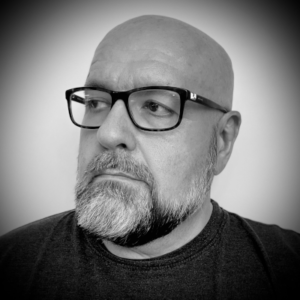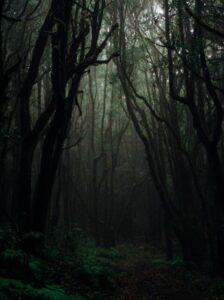The NoSleep Podcast is a horror fiction podcast created and hosted by David Cummings. David Cummings is the creator and host of The NoSleep Podcast, the preeminent audio horror fiction podcast. Started in 2011, the podcast now has over 500 episodes and has been downloaded more than 200 million times. As a voice actor, Cummings has appeared on many audio fiction podcasts and has voiced roles alongside notable actors such as Elijah Wood, Kate Siegel, and Kristen Bell. Born in Toronto, Cummings now lives near Niagara Falls in Canada with his wife Kelly.
The following is the result of a very pleasant interview I did with David, where we chatted about evil voices, the development of stereotypical evil in horror, and the importance of voice diversity in an audio horror production. This text is interactive, and throughout you will find small audio clips which you are encouraged to click on while reading for a full immersive experience. Note that the audio quality of some of the clips isn’t perfect due to recording issues.
Enjoy! Or rather… Brace yourself…
The evolution of ‘evil voices’ in the horror genre

What is it about certain voices that makes us feel uneasy or even scared? It can be difficult to pinpoint one specific feature, and as we will see throughout this article, context is paramount to how we perceive certain voices. For voice actors, one aspect of conveying feelings of horror, or evil characters is to try to imbue some menace to the voice, for example through that teeth-gritting angry sound that can come across as threatening, or by deepening the voice.
David: “Traditionally, an evil voice kinda has to be a low, almost monotonous male voice. Deep in frequency, so it’s that low, slow talking, not a lot of inflection. It’s right down here”.
Classic horror voice actors that in many ways fit within this traditional paradigm of a low, slow, male voice are for example Vincent Price and Bela Lugosi. However, the horror genre has evolved significantly since then, and we see that reflected in the fact that there is a greater variety in what types of voices and voice qualities portray evil or feelings of horror in literature, movies, podcasts etc. These days in horror literature we’re seeing a tendency for the villains to be villains on the count of being friendly – too friendly in fact to the point where it gets unnerving.
David: “When there’s a lot of inflection, when people go way up high and then way down low and there’s a lot of that lilting sound to the voice, we interpret that as being friendly, as being non-threatening”.
We’re seeing more and more in horror where villains are super friendly, and they’re always smiling but they have those dead eyes, that make you assume that maybe, in the wink of an eye, they can change and might just stab you in the back. The way that can translate into audio, obviously, is through the voice.
Diversity and versatility in evil voices
But men aren’t the only villains in horror, so what about the female voices? We started talking about one aspect of evil female voices:
David: “As a culture, as a society, we have to stretch a little bit to have a female villain. I don’t know how deep that goes into the patriarchal society where women are usually the caregivers, the mothers. We seem to always turn to women to be providers of comfort and solace. So a female character that is evil, there almost has to be a different tone to it, like you could have a female voice that takes on a low quality”.
Here you’re taking a female character and almost making her more masculine by giving her a kind of ‘rough-and-tough’ quality. Maybe the woman in question has lived a bit of a hard life, maybe she drinks and smokes, and has now decided to go on a killing spree. One way of conveying that to the listeners is through the character’s voice, and David exemplifies this by mentioning voice actress Erin B. Lillis, who is very good at voicing precisely these types of female villains. You can listen to Erin’s amazing voice here.

If we go back to the idea of a character that is a mother and plays into the sweet, caring role we generally hold women to be, we suddenly touch on a different aspect of female villains. David talks about a story they did on the podcast some years ago about a mother who was harmful to her children, abusive, but she wasn’t doing it with rage. She was trying to be a good mother, but in reality doing very messed up things. In that case the actress had to, on the one hand, portray this very sweet, loving mother while also giving her an edge of insanity that showcases the mad stuff she is doing. This particular character ended up being played very sweet and conveying warmth, but the context made that so much more creepy, precisely because what sounds like is being done with love is actually being done maliciously.
David: “And that juxtaposition, that change, where something sounds loving but is scary, that dissonance is very scary”.
There has to be diversity in voices in terms of gender and age, in order for David and his team to be as authentic as possible, and to convey the written word of the authors as best they can. What constitutes horror and creepiness in a voice isn’t just one-note anymore (e.g. the low talking man), it is much more complex. And lucky for us listeners! More diversity gives us more scary characters to pick from, and we get to listen to so many amazing voice actors and actresses.
Finally, we talked about versatility which is also something David looks for in the voice actors he puts on the show. Some actors on the podcast are very versatile and can play characters in a wide age range, or do different types of accents, like Erika Sanderson whose amazing voice you can listen to here. However, depending on the kind of voice the actor/actress has, versatility might not even matter.
David: “There are voice actors out there, even people on our show who don’t really change their voice much. I think about Nikolle Doolin who is very well known for having a lower smokier voice. Other than some stories where she might do a southern accent, Nikolle generally just has own voice and that’s what she does”.
Check out Nikolle’s amazing voice here and hear for yourself.
The voice quality of the actor is important but what David doesn’t want are the classic voice over types of voices (what we would associate with commercial voices), because they are perceived as less authentic. Funnily enough, David, who has had a long career in voice over, does a perfect impersonation of this.
You can read more about the NoSleep podcast here. You can also listen for free on your favorite podcast platform.
Sofia Navarro Beck is a MA student of Linguistics and long-time listener of the NoSleep podcast.







